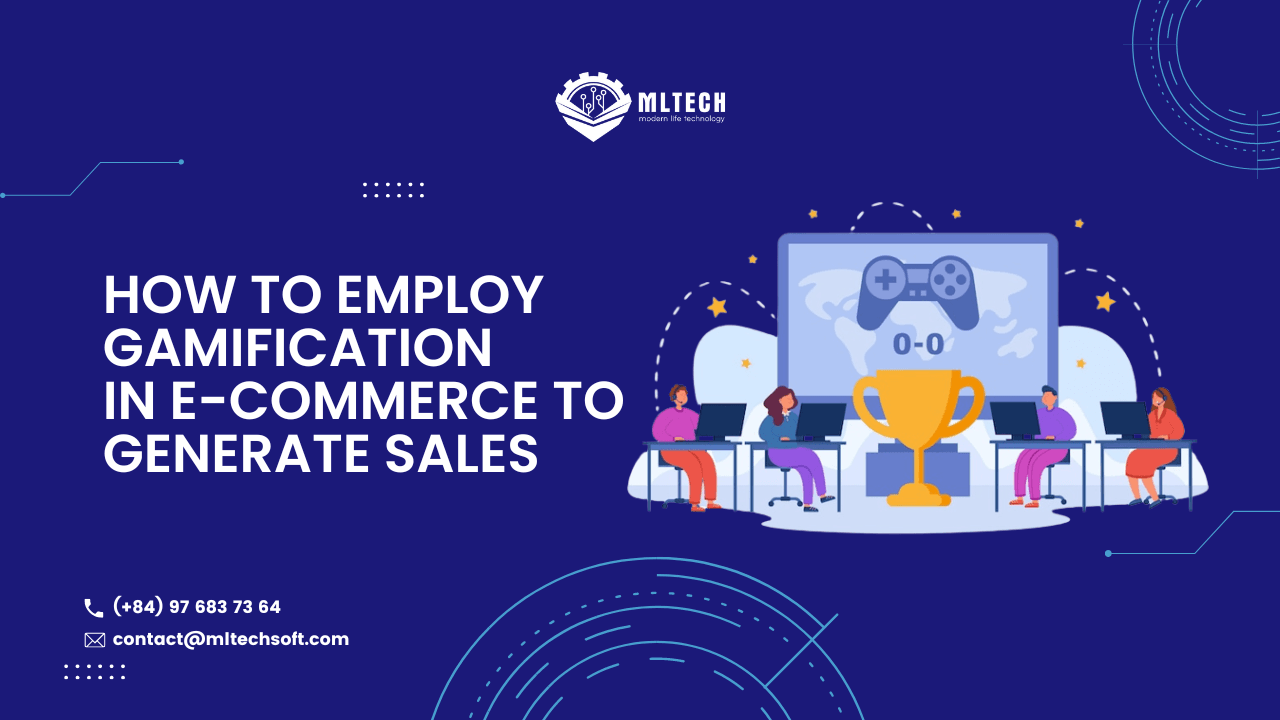Scroll down for more
How to Employ Gamification in E-Commerce to Generate Sales

Creating a memorable unboxing experience, earning customer loyalty, and dealing with abandoned carts are just a few of the difficulties faced by e-commerce businesses of all sizes. These issues can all be solved in common ways. But adding gamification to your e-commerce app or website is an effective way that is frequently ignored.
In this post, MLTech Soft will show you the main advantages of e-commerce gamification and provide real-life examples employed by top brands.
1. What is Gamification?
Gamification is the strategic attempt to enhance systems, services, organizations, and activities in order to create similar experiences to those experienced when playing games in order to motivate and engage users.
It uses a sense of reward and achievement to encourage us to take the desired action. Integration of game mechanics into an e-commerce application can boost sales and attract more customers.

2. Key Benefits of Gamification in E-commerce
Gamification has enormous potential for enhancing your e-commerce business since it creates a satisfying emotional experience. Gamification is a modern marketing strategy used by profitable e-commerce platforms to increase brand awareness, draw in new customers, and boost sales. Gaining a competitive advantage can be tremendously aided by gamification solutions.
Here are some key benefits of gamification in e-commerce:
Boost customer engagement and sales
When used effectively, marketing gamification technologies raise consumer loyalty to a retailer's brand and thus improve sales. 60% of consumers stated they would be more likely to purchase from a brand if they loved playing a game with it, according to the gamification survey.

Enhance Brand Awareness and Customer Retention
Retail brands are always in search of new ways to reach a new audience and retain their existing customers. Gamification implemented in the online retail industry provides customers with an opportunity to get acquainted with a brand in an unobtrusive way. These interactions will ensure a positive attitude towards the brand and benefit it in the future.
Increase customer loyalty
Offering an exciting and satisfying prize or a special discount on the next purchase will lead to customer satisfaction and loyalty. Using a loyalty point system, which allows customers to collect badges, points, rewards, etc., can increase customer loyalty, encourage more people to come back to your platform more frequently, and increase engagement on your app or website.
Get More Email Subscribers Easier
Using gamification on your e-commerce website or in your e-commerce app will persuade users to enter their email address in exchange for incentives. Customers are much more motivated to snag a discount coupon on some occasions, such as Black Friday, which makes the strategy more effective.
3. How to Gamify Your E-commerce Website or App: Successful examples

E-commerce websites or apps with in-app gaming experiences can increase sales and attract more customers to your online store. The essential driver that will encourage customers to play is the reward they will receive at the end of the game.
There are plenty of reasons for rewarding users, including giving them a prize or discount if they share a game with friends or their achievements on social media. So, why don’t you use gamification for your e-commerce website or app?
We will give you a few gamification website and app examples to consider:
- Implement quizzes or challenges.
- Give rewards and badges for achievements.
- Offer loyalty programs.
- Build virtual communities.
Gamification is effective when used properly. To show you that gamification in e-commerce actually works, we've gathered five games that were successfully launched by well-known e-commerce companies.
AliExpress
AliExpress provides a fantastic illustration of how gamification is applied to e-commerce platforms. The retailer's shopping application now includes a game. Customers can earn coins by participating in their "Bubble Challenge" game in order to swap them for exclusive two-dollar AliExpress coupons, coupons from vendors,...
AliExpress became one of the most widely used online shopping sites thanks to this gamification innovation. By offering a fun way to get discounts, their gaming area aids in keeping clients.
Nike Run Club
Another worthwhile case study of gamification on e-commerce websites is the Nike Run Club app, which was initially created to motivate people to keep their training consistent. The app offers not only training related features such as GPS-tracking or guided workouts but also in-app challenges that enhance user engagement.
By participating in the challenges that are available for a limited time, the Nike app’s users compete with friends or other users. Every time users complete a challenge, they unlock achievements to get prizes. This makes customers more engaged, while the urgency of the challenge retains customers within Nike’s community.
Burger King
According to the game-like challenge presented by Burger King, customers had to download their app and find a McDonald’s restaurant within 600 feet to activate the offer: a one-cent Whopper. Once the order was placed, the app navigated the user to the nearest Burger King’s restaurant. As a result, the gamification made Burger King’s app the most downloaded app in the Apple App Store for several days.
Airbnb
A nice illustration of how a virtual community for generating leads might be developed is Airbnb. The property management website gives its Japanese users the chance to earn 1 point for every 200 yen spent on lodging reservations. Users can then use them inside a network of T-Point Alliance partners. The campaign not only encourages Airbnb users to stay longer but also increases future sales.
Conclusion
Although there are numerous e-commerce gamification techniques to use, you should develop a strategy that will meet your company's needs. Remember that employing gamification strategies at random is not a good idea. Instead, consider the needs of your target audience, gain an understanding of those needs, and then come up with activities that will appeal to them.
Get our blog
Want the latest and greatest from our blog straight to your inbox? Chunk us your details and get a sweet weekly email.
Read more in our blog

Project Management
The Rise of AI-Generated Code: Opportunities & ChallengesExplore how AI-generated code is transforming programming with tools like GitHub Copilot and AlphaCode. Learn about the opportunities it offers—faster development, accessibility—and the challenges like security and ethics we must address.

Project Management
The Impact of Dynamic Pricing on Customer BehaviorExplore the impact of dynamic pricing on customer behavior and learn how to implement effective pricing strategies.

Project Management
Focus in Scrum: Keeping Your Team on TrackDiscover effective strategies to maintain focus within your Scrum team, overcome common challenges, and boost productivity.
MLTECH SOFT